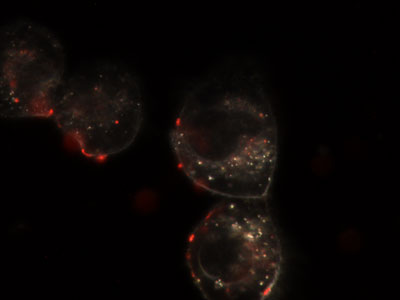| Sep 02, 2009 |
Centre for NanoHealth researchers to study safety of nanoparticles |
|
(Nanowerk News) Researchers at Swansea University’s Centre for NanoHealth have been awarded £1 million by the Research Councils' Nanoscience through Engineering to Application cross-council programme, led by the Engineering and Physical Science Research Council (EPSRC), to analyse the levels at which nanoparticles can be deemed safe within cells.
|
|
The funding, awarded as part of a £1.4 million research grant to Swansea University and collaborators at the Institute of Materials Research at the University of Leeds (EPSRC), will enable Swansea University to develop techniques to accurately measure the nanoparticle dose delivered to biological cells, track the dose dilution as cells reproduce and provide vital information for researchers studying any potential toxic responses.
|
 |
| CellsQD0hr: Optical microscopy image of nanoparticles (CdTe quantum dots) attached to the outer side of cell membranes. The image is taken 1 hour after introduction of the nanoparticles to the cellular environment. The attachment and subsequent internalisation of the nanoparticles is driven by a natural cellular process known as Endocytosis, this will deliver the particles into small internal vesicles (the endosomes) which are visible in the image as bright white spots within the cell.
|
|
The four year project will also ensure closer collaboration between researchers at Swansea University’s School of Engineering and School of Medicine, both of which have undertaken significant research into nanotechnology, nanometrology and nanotoxicology over the last 15 years.
|
|
Professor Huw Summers, lead researcher and Chair in Nanotechnology for Health at Swansea University said: “Current practice in the assessment of toxic dose uses bulk solution measures such as milliliters per gram to determine correct dosages rather than the fundamental measure of particle number. As the size of nanoparticles can vary significantly, some being as small as a protein molecule, determining optimal dosages for use in healthcare and beauty products such as sunscreens or cell-based diagnostics will be crucial.
|
|
“Our research which uses light emitting nanoparticles as optical markers within living cells that give an individual signal relating to cell generation will also provide vital information for our colleagues in nanotoxicology about how the dose evolves as cells divide and nanoparticles are passed onto future cell generations.”
|
|
In recent years the application of nanotechnology to medicine has sparked the imagination of life scientists, engineers, clinicians and industry around the world.
|
|
These nanoscale technologies, for example, will enable researchers and scientists to apply engineering methodologies to successfully build and repair tissues such as cartilage and skin using advanced cell culture techniques, act as an early warning system for cancer or diabetes and make products like sunscreen or antiperspirants more effective.
|
|
Professor Summers explains: “We’ve been using nanoparticles for tracking lineage, proliferation and inheritance in populations of biological cells for a number of years. Using fluorescent nanocrystals known as quantum dots, we now have established protocols for introducing nanoparticles into cells and quantifying their interactions within the biological environment through optics-based experiments and detailed computational simulations.
|
|
“This enables us to not only predict and control the way cells and structures behave, but test these before they are introduced, reintroduced or implanted in the body to give better results in future healthcare applications.”
|
|
|
|
The project research team will comprise 11 researchers, six academic investigators, three postdoctoral researchers and two PhD students.
|
|
In addition to optical tracking of nanoparticles in cells, measurement and computer simulation of the nanoparticle dose evolution, biological assessment of particle uptake and toxicology assays on skin, lung and immune system cells; Swansea University will also be working with the Institute of Materials Research at the University of Leeds which will be providing high resolution electron microscopy to image nanoparticles in cells and provide chemical analysis.
|
|
The project is closely linked to the Centre for NanoHealth initiative at Swansea University which stems from a number of joint research programmes between the School of Engineering and the School of Medicine and is expected to position Swansea University as the front-runner in nanotoxicology research in the UK.
|
|
The Centre for NanoHealth is the first state-of-the-art NanoHealth facility of its kind in Europe, bringing together the expertise of clinicians, life scientists, engineers and industry to develop cutting-edge technologies and devices for the benefit of patients everywhere.
|
|
The Centre for NanoHealth has been made possible after securing more than £10 million from the European Regional Development Fund through the Welsh Assembly Government.
|

